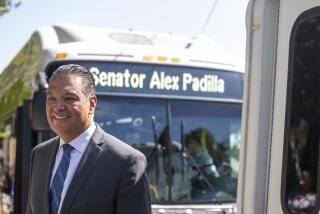EPA plans to sharply reduce inspections
WASHINGTON — The Environmental Protection Agency plans to substantially reduce inspections and civil enforcement cases against industry over the next five years, arguing that focusing on the biggest polluters would be the most effective way to clean up air and water.
In a draft strategic plan, the EPA proposes to cut federal inspections by one-third from the 20,000 inspections it conducted in the last fiscal year, ended Sept. 30.
Moreover, it plans to initiate about 2,320 civil enforcement cases a year, compared with the 3,000 cases initiated last fiscal year, a 23% reduction.
The EPA said the shift for fiscal years 2014 to 2018 is not a retreat from enforcement but a more effective allocation of resources.
“From our work on the biggest enforcement cases, such as the BP Deepwater Horizon spill, to aggressively pursuing smaller cases that can reduce harmful health impacts and have the greatest environmental benefit, our enforcement work will continue to save lives and protect our environment,” said Alisha Johnson, an agency spokeswoman.
Representatives from industry organizations that frequently criticize the EPA, such as the U.S. Chamber of Commerce and the National Mining Assn., had no comment on the proposed changes.
Environmental groups said they were alarmed.
“It is bewildering why the EPA would pull cops off the beat who’ve been protecting our air and water from big polluters,” said Michael Brune, executive director of the Sierra Club. “We urge the EPA to reconsider these proposed cuts.”
In the draft strategic plan, the EPA said that focusing on the biggest violators would lead to the greatest cuts in pollution. The EPA also said that it planned to emphasize real-time monitoring of emissions to prevent pollution, which, if successful, would also lead to a decline in enforcement actions.
Still, some former EPA lawyers questioned the strategy. They said the EPA has long proposed real-time emissions monitoring but industry has successfully stymied implementation.
Eric Schaeffer, a former director of the EPA’s Office of Civil Enforcement, said that tough enforcement in many ways was the most effective deterrent.
“They want to get at prevention, but the government in general is measured by what it does, and that is enforcement,” said Schaeffer, executive director of the Environmental Integrity Project, a Washington research and advocacy group.
“If this is signaling some kind of wind-down in the bigger enforcement cases and bigger pushes that only EPA as the federal regulator can do, then it’s worrisome,” he said.
In the draft strategic plan, the agency cites budget constraints as a factor in reshaping its approach. But Paul Cort, formerly an EPA lawyer, said the agency could have made cuts to other programs that “would have less impact on public health.”
“It’s a preemptive surrendering by the enforcement division,” said Cort, now with environmental group Earthjustice. “It’s like they are saying, ‘Take our money, and apply it to other parts of the agency.’ It’s disturbing that they would voluntarily chose to cut money that goes to efforts important to protecting the public.”
More to Read
Inside the business of entertainment
The Wide Shot brings you news, analysis and insights on everything from streaming wars to production — and what it all means for the future.
You may occasionally receive promotional content from the Los Angeles Times.







